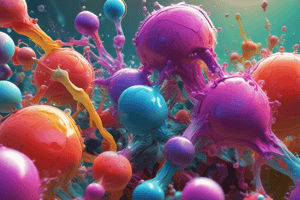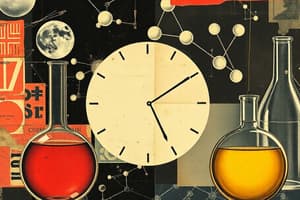Podcast
Questions and Answers
Which of the following best describes a compound?
Which of the following best describes a compound?
- A mixture of two or more elements in any proportion.
- A substance that cannot be broken down chemically.
- A material that can be separated by physical means.
- A substance composed of two or more elements chemically bonded in a fixed ratio. (correct)
Which physical property describes a substance's ability to be drawn into wires?
Which physical property describes a substance's ability to be drawn into wires?
- Malleability
- Lustre
- Ductility (correct)
- Viscosity
Which type of mixture has components that are not uniformly distributed?
Which type of mixture has components that are not uniformly distributed?
- Homogeneous mixture
- Solution
- Heterogeneous mixture (correct)
- Compound
What indicates that a chemical change has occurred?
What indicates that a chemical change has occurred?
Elements in the same column of the periodic table have what in common?
Elements in the same column of the periodic table have what in common?
Which of the following is a characteristic of noble gases?
Which of the following is a characteristic of noble gases?
What is the primary characteristic of a homogeneous mixture?
What is the primary characteristic of a homogeneous mixture?
Which of the following properties describes a substance's resistance to being scratched?
Which of the following properties describes a substance's resistance to being scratched?
What is the boiling point of a liquid?
What is the boiling point of a liquid?
Which property of a substance can be determined without altering its chemical composition?
Which property of a substance can be determined without altering its chemical composition?
What type of elements are characterized by being dull and brittle?
What type of elements are characterized by being dull and brittle?
The ability of a substance to dissolve in a solvent is referred to as what?
The ability of a substance to dissolve in a solvent is referred to as what?
The elements in the 17th column of the periodic table are known as what?
The elements in the 17th column of the periodic table are known as what?
Which of the following is NOT a visual indication of a chemical change?
Which of the following is NOT a visual indication of a chemical change?
Flashcards
Element
Element
A substance that cannot be broken down into simpler substances by chemical means.
Compound
Compound
A substance composed of two or more elements chemically bonded together in a fixed ratio.
Homogeneous Mixture (Solution)
Homogeneous Mixture (Solution)
A mixture where the components are uniformly distributed throughout.
Heterogeneous Mixture
Heterogeneous Mixture
Signup and view all the flashcards
Physical Properties
Physical Properties
Signup and view all the flashcards
Viscosity
Viscosity
Signup and view all the flashcards
Solubility
Solubility
Signup and view all the flashcards
Chemical Properties
Chemical Properties
Signup and view all the flashcards
Change in color
Change in color
Signup and view all the flashcards
Change in odor
Change in odor
Signup and view all the flashcards
Formation of a gas
Formation of a gas
Signup and view all the flashcards
Formation of a precipitate
Formation of a precipitate
Signup and view all the flashcards
Energy absorbed or released
Energy absorbed or released
Signup and view all the flashcards
Family
Family
Signup and view all the flashcards
Period
Period
Signup and view all the flashcards
Study Notes
Matter Classification
- Matter is classified as either a pure substance or a mixture.
- A pure substance has a fixed composition, cannot be separated by physical means, and is classified as either an element or a compound.
- A mixture has a variable composition and can be separated by physical means. Mixtures are further separated into solutions.
Physical vs. Chemical Changes
- Physical changes alter a substance's form but do not change its composition. Examples include changes in state (melting, freezing) and changes in shape or form.
- Chemical changes result in the formation of new substances with different properties than the original substance. Examples include burning, rusting, and decomposition.
- Chemical changes are often indicated by observable signs such as color change, gas production, precipitate formation, or temperature change.
Physical Properties
- Physical properties describe the characteristics of a substance without changing its composition.
- Examples include texture, luster, odor, state (solid, liquid, gas), hardness, melting point, clarity, malleability, viscosity, boiling point, and solubility.
Chemical Properties
- Chemical properties describe a substance's ability to undergo a chemical change or reaction to form a new substance.
- Determining these properties involves subjecting a substance to a chemical reaction.
Indicators of Chemical Changes
- Formation of a gas
- Color change
- Formation of a precipitate
- Temperature change
- Release of light or heat energy
Classification of Elements in the Periodic Table
- Elements are arranged in the periodic table according to increasing atomic number.
- Elements are grouped into rows (periods) and columns (families/groups), which reflect their shared properties.
- Families/groups of elements have similar physical and chemical properties.
Studying That Suits You
Use AI to generate personalized quizzes and flashcards to suit your learning preferences.





